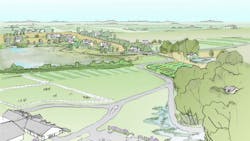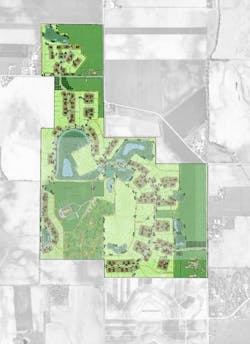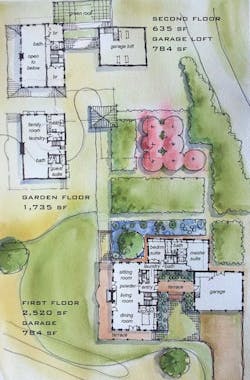Top Designs: Serosun Farms—a Taste of Farm Life in the Chicago Suburbs
Kane County, Ill., is something of a dichotomy—a Chicago suburb with a thriving farm base. But as development continues to push west from the city, the county’s concerns about the future of that farmland have increased.
Developer John DeWald, co-founder of John DeWald & Associates, had an idea: Why not purchase some of the farm acreage and create a sustainable farming community with new homes? The concept that eventually became Serosun Farms is now under construction in Hampshire, Ill. It’s centered on a working organic farm and includes hundreds of acres of restored prairie and woodlands. As DeWald explains, the homes will adhere to passive construction and design guidelines, but they’re really secondary to the healthy lifestyle offered at Serosun Farms.
DI: When did you start thinking about the concept of a sustainable farming community?
John DeWald: My sister purchased a portion of the Serosun Farms property back in 1999 to build a horse farm. By 2003, she realized that her farm was at the edge of Chicago’s suburban sprawl and became concerned that someone would build a subdivision across the road. I thought, why don’t we take a look at what’s around here and protect this area?
I started talking to Kane County officials about the Serosun concept, and they saw it as a great opportunity to enhance their farmland preservation efforts. While the county has been buying up rights to farms out in the western suburbs, their real challenge is in farm areas like this one that are near the suburban fringe. I worked with them on a new zoning category that would allow us to do Serosun Farms. By 2009, the county had passed an amendment to its 2030 plan that added the new category. Our plat was subsequently approved, but because of the market crash we had to wait a couple of years before we could go forward with development.
This sketch by Kettelkamp & Kettelkamp Landscape Architecture, in Evanston, Ill., shows the view from the barn at Serosun Farms toward the northwest.
DI: Why do you think Serosun Farms is an idea whose time has come?
JD: Less than 7 percent of the food eaten in the Chicago area is actually grown or produced in Illinois, which is interesting considering that Illinois has some of the best soils in the world. There’s been a big push to preserve farmland and create more local farming to produce more of the food we eat. It’s time for us to find ways to integrate farms into edge communities, which would also help preserve some of the open space.
I also think that people are tired of traditional suburbs, which can be kind of soulless. They’re more interested in communities than subdivisions. What makes Serosun Farms a community is that it integrates a lot of uses and activities; it’s not just a bunch of houses.
DI: How is Serosun Farms different from other communities that focus on sustainability, such as Prairie Crossing, in Grayslake, Ill., and Serenbe, in Chattahoochie Hills, Ga.?
JD: Prairie Crossing and Serenbe have some of the same elements as Serosun. We’ve talked with the folks at Prairie Crossing and incorporated some of their ideas, models, and lessons learned. But Serosun is, at its core, a farmland preservation project. It’s focused on being a farm first, then a residential development. I think Prairie Crossing and Serenbe are the other way around.
Serosun Farms is also a little different from a housing perspective. Our homes will be one-of-a-kind custom with a farm preservation emphasis. Essentially, we’re buying four acres for every acre we sell, which allows us to be more upscale in lot and home types. And the designs themselves are more rural, in keeping with the character of the area.
DI: How large is the community, and what will it consist of when completed?
JD: Serosun Farms is approximately 410 acres and will have 110, 1-acre home sites, so the homes occupy about 25 percent of the entire property. There’s a 160-acre working farm and more than 300 acres of open space, including a restored prairie and wildlife habitat; a 40-acre savannah; and about 8 miles of trails.
There will also be a large equestrian center; a community center with a swimming pool, tennis, and basketball courts; community gardens for residents to grow their own fruits and vegetables; a stocked fishing pond; a restaurant; and a farmer’s market. Community activities such as fall and spring festivals and holiday festivals will foster social life.
Serosun Farms truly promotes a healthy lifestyle, providing residents with immediate access to fresh organic produce, free-range poultry, and grass-fed beef. The soil has been restored and preserved to make it nutrient-rich.
Homes will occupy only about 25 percent of the Serosun Farms property; the rest is allocated to a working farm, restored prairie, and woodlands, and other open space.
DI: What buyer segments do you anticipate?
JD: We’ve identified four demographics: equestrians who want to live near their horses; business executives, business owners, professionals, and entrepreneurs; second-home buyers looking for a quick getaway in the country; and retirees or people nearing retirement who want an active lifestyle in a rural setting but not the responsibilities of maintaining a farm.
In the retiree group are many people who either grew up on a farm or their grandparents had one, and they want to get back to that life. It’s also appealing to have a home that their grandchildren will love to visit. Yet we’re only a 40-minute drive from O’Hare Airport and an hour from downtown Chicago.
DI: Have you selected builders and architects?
JD: We have three architects and four builders, and will probably add more. Buyers can bring in their own builders and architects, with our approval. The homes at Serosun must be sustainable and healthy and meet certain requirements. We need builders and architects who have a thorough understanding of sustainable techniques, technologies, and design standards, and are accustomed to dealing with wells, septic systems, and other aspects of country life.
Plus, we’re pushing more traditional American styles that fit the rural ambience such as Craftsman, Farmhouse, Foursquare, Prairie, and Victorian, so our architects need to be proficient in these authentic styles.
The homes will range from approximately 2,500 to 6,000 square feet and be priced from the $600,000s to around $2.5 million. The price includes a 1-acre home site.
DI: Tell me more about the sustainable building and design requirements.
JD: The homes will incorporate green features such as passive design elements, rainwater collection systems, and geothermal heating and cooling. They’ll have a high level of indoor air quality. One of our goals is to provide 70 to 80 percent of our energy through clean, renewable, on-site sources such as wind, solar, and geothermal.
DI: What’s the status of construction and sales?
JD: We have five reservations for the first 14 lots that have been released. The grand opening is in mid-May; our model home will be completed by then. The first roads should be completed by early June, which is when we’ll start lot closings and building the first custom home.
The model home is 4,890 square feet, not including a 784-square-foot garage loft. The plan wraps around a landscaped terrace and courtyard and features a first-floor master. The “garden floor” is actually an English garden basement with large, deep windows.
DI: How have visitors reacted to Serosun Farms?
JD: It’s interesting how the farm captures people’s imaginations today. When buyers come out here, they’re really focused on lifestyle first and home second.



